This bird’s questioning “wurp?” call is a common sound in desert habitat in and around Tucson. With the male’s handsome glossy black plumage, flashing white wing patches and ragged crest this bird often described as a ‘black cardinal with a red eye.’ The female is similarly attired but in a matte slate gray that is quite beautiful and bit more understated than the male. In the winter these birds gather together in flocks and are commonly seen feasting on berries of the native mistletoes clumped in the branches of palo verde or mesquite trees. The slim, black silhouette of this bird may seem a common sight in regions of Tucson with desert vegetation, but this bird has a complicated seasonal migration pattern that is still not fully understood by scientists. Phainopeplas may actually be one of the only birds in North America to nest first in one habitat and then again in another all in the same year. In the spring these birds will nest in Sonoran Desert Habitat, often in a tree that is hosting native mistletoe so a steady food supply is always within wing’s reach. When temperatures begin to rise in early summer, these birds gather in nearby riparian woodlands or higher elevation oak woodlands (such as Madera Canyon) and then raise another brood of chicks. These birds with their beautifully simple coloration may actually have far more complicated parenting lives than before thought.

